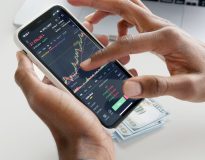Consumers are becoming increasingly aware of where their products are coming from. Ethically sourced materials have become a selling point for companies around the world. More and more companies are working on ditching conflict minerals and ensuring that their products are not associated with human rights abuses. Blockchain can put an end to conflict minerals globally.
Note that conflict minerals remain a big problem today. Take the Democratic Republic of Congo (DRC), for example. It is the second largest country in Africa, a land full of natural resources such as gold, diamonds, and oil. More than 64% of the Congolese population is extremely poor — living on less than $2.00 a day.
Conflict Minerals in Congo
The country has been torn apart by political conflicts and corruption. In this war-torn nation, only in 2017 and 2018 alone, more than two million people have been displaced. More than five million people died in the region between 1998 and 2007. That is more than half a million people per year.
What is worse is that armed groups present in the country exploit Congo’s natural resources to fund these conflicts. In 2008, they were able to raise over $180 million from mining there. Many of the mines in Congo function through the use of intimidation, slavery, and child labor.
These children are forced to work in extreme conditions at all points of the supply chain, from mineral excavation and processing up until trading and transportation. Rather than going to school or playing with their friends, these children are being forced to spend days sorting through dirt to find precious minerals. The mines are their playground, and the soil is their toy.
However, unlike conventional playgrounds, these are anything but safe. Mines are hazardous and are no place for a child. Children in mines are often injured or killed from mining accidents. Death and suffering from poisoning due to overexposure to mercury — which is used to process gold — is common.
Watch an episode of the 2008 series of “House,” and watch an actor try to portray what metal poisoning feels like. Now picture these small children exposed to this torture. Both adults and children develop respiratory diseases from exposure to dust and other harmful substances present in mines.
Illegal mines damage wildlife by destroying habitats in surrounding areas killing birds, animals, and other creatures living there. Hunting pressure and commercial bushmeat trafficking also have devastating effects on wildlife.
Steps to Decrease Forced Labor and Human Right Abuses
Nations throughout the globe are finally beginning to realize that something needs to be done. Many of the materials these illegal mines produce are present in objects we use on a daily basis.
The four most commonly mined conflict minerals are gold, coltan, wolframite which is used for tungsten, and cassiterite, which is used for tin. These items are found throughout items many of us use on a daily basis — including TVs, cellphones, cars, computers and many other electronics.
Additionally, these minerals are also found on airplanes and larger devices that primarily function with the use of electronics. Considering many of these items are developed within the U.S., in 2010 a new set of regulations was introduced to help aid in the reduction of forced labor, human rights abuses, and wildlife losses.
The Dodd-Frank Act of 2010 and Other Regulations
Section 1502 of the Dodd-Frank Act requires that businesses operating in the United States ensure that the resources they are using in their products are not being sourced from conflict mines. Again, this is in the mining for gold, coltan, wolframite which is used for tungsten, and cassiterite which is used for tin.
The Dodd-Frank Act was made in 2010 in an era of responsibility — when all people are calling on global initiatives for protection for those who don’t have a voice. It calls on companies that require these resources to perform due diligence when sourcing materials.
The 2010 act and other regulations require that businesses keep a better eye on their supply chains, which ultimately means increased transparency and gaining the ability to tell where their company materials come from. This legislation also requires visibility about the types of labor practices being conducted in those regions.
Similar regulations are now being established within the EU as well. The EU Conflict Minerals Regulation will come into effect in January 2021. Like the Dodd-Frank Act, it requires businesses operating in the EU to do their due diligence when sourcing materials for their products.
Companies will then have to provide a Conflict Minerals Report, which would need to be audited by an independent audit company, whose costs typically start from $25,000 per report for a small company, and from $100,000 for a larger one.
All of this means a lot of expenses that small, medium-sized, and large businesses will have to account for down the road. It’s estimated these new regulations would affect between 600 to 1,000 EU businesses.
A 2016 study by Amnesty International found that companies like Apple, Microsoft, and Samsung possibly used cobalt in their products that had been collected from mines using child laborers. That means many of the iPhones being used daily and the Microsoft computers we are using — currently, operate on child labor.
So although the Dodd-Frank Act went into law in 2010, the issues remain and are spreading on a massive scale. The advent of millennials becoming a more substantial purchasing power will help all of us. The millennial has their eyes cast upon saving the planet — and gaining civil rights for all persons globally. Companies will be forced to show accountability at some point.
The Effects of New Regulation
The Dodd-Frank Act and the EU mineral regulations have brought up intense auditing systems that require companies to spend significant amounts of money to ensure their products are being developed ethically. Despite how expensive these audits are, they’re not genuinely effective — but they will be.
Modern auditing is mainly performed through random sampling, meaning verification is only conducted from random information. This means a business might be able to luck out (as they suppose) for a while — but not forever.
Blockchain can track everything, making random sampling audits using a method that can look into the past. These companies will do better in these coming future audits — if they will fix their lapses of judgment (and mining), now.
How Blockchain Functions in Auditing
Blockchain technology has the potential to ensure compliance, reduce audit costs, and protect human rights, eliminating forced and child labor in mineral mining. Although this technology is mainly used to increase supply chain efficiency, it can be adapted to make sourcing more ethical as well.
With all points in a supply chain linked to the blockchain, all aspects of mines can be uploaded to the chain, such as details about the workforce, production, quality of minerals, the prevalence of minerals, and many others. With blockchain, every aspect of mineral products can be logged and looked back at when necessary.
Blockchain requires a majority vote for previous information, or “blocks,” to be altered, which ultimately ensures there would be no chance of foul play. Each member of the chain will have the ability to see what has been added, and exactly when it is added.
Does Blockchain Mean the End of Auditing?
Auditing institutions can learn to adopt the technology to provide a more efficient and effective auditing service. Currently, auditing relies on methods that sometimes offer illegitimate results, and an audit conducted through random sampling can hardly be considered an audit at all, but more a “game of chances.”
However, auditing companies could develop their own blockchain services. Plus, with blockchain auditors could provide more consistent testing. Not only auditors, but corporations themselves could be positive that they are not utilizing illegal or child labor practices.
Current Blockchain Use Cases in Eliminating Conflict Minerals
Eliminating conflict materials has never been an easy task. Even with global companies performing their due diligence, there’s often no way for them to know or find out if conflict minerals got their way into the supply chain due to the number of intermediaries the mining industry traditionally has.
Until recently, the $600 billion mineral industry did not have any real means actually to track itself. It all started changing just recently, with the help of blockchain.
German company Minespider has introduced a blockchain-based solution that tracks the entire mineral cycle, from mining to shipment and payment. Their system works in three stages: certification, transfer, and report.
During the first certification stage, Minespider gets certifications of mineral sources from their partner company, BetterChain. The confirmed, certified mines then receive electronic certification tokens, which are based on their production tonnage. These certifications are subject to annual audit and review.
During the transfer stage, the purchaser gets a number of tokens equivalent to the ordered tonnage, transferred to their account via blockchain. In the third and final reporting stage, the report is generated, showing the percentage of documented material that moves through the supply chain. This makes the whole process as transparent and straightforward as possible, allowing mineral mining companies to ensure compliance and save on auditing costs as well instantly.
Making Society Safer with Blockchain
Why do conflict minerals continue to exist? Why do workers continue to be injured or killed in mines? The answer is simple: our supply chains lack the necessary amount of transparency. Blockchain technology can sustain more transparent supply chains.
Its ability to act as an immutable digital ledger is improving industries across the globe. It is making the medical industry more effective, decreasing shipping times with better and swifter communication, changing the way we bank, and increasing trust and accountability throughout business transactions.
By using blockchain to increase transparency in the supply chain, we are taking the first step to ridding the world of conflict minerals altogether.










